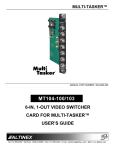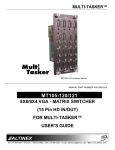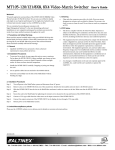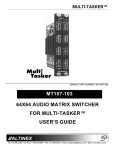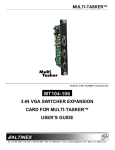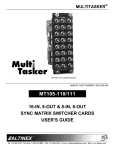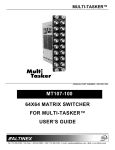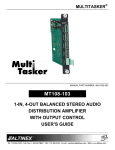Download Altinex MT105-131 User`s guide
Transcript
MULTI-TASKER™ MT105-130 is shown above. MANUAL PART NUMBER: 400-0368-001 MT105-130/131/132 8X8 CAT5 - 4TP/3TP/2TP MATRIX SWITCHER CARDS FOR MULTI-TASKER USER’S GUIDE MULTI-TASKER™ TABLE OF CONTENTS Page PRECAUTIONS / SAFETY WARNINGS .............. 2 GENERAL ................................ ......................... 2 INSTALLATION ................................ ................. 2 CLEANING ................................ ........................ 2 FCC / CE NOTICE................................ ............. 2 ABOUT YOUR MT105-130/131/132.................... 3 TECHNICAL SPECIFICATIONS .......................... 3 PRODUCT DESCRIPTION ................................ .. 4 APPLICATION DIAGRAM................................ .... 5 DIAGRAM 1: MT105-130 TYPICAL SETUP ...... 5 DIAGRAM 2: MT105-131 TYPICAL SETUP ...... 6 DIAGRAM 3: MT105-132 TYPICAL SETUP ...... 7 DIAGRAM 4: INTERNAL VIEW ......................... 8 INSTALLING YOUR MT105-130/131/132............ 9 OPERATION................................ ........................ 9 RS-232 CONTROL................................ ............ 9 DESCRIPTION OF COMMANDS ...................... 9 SUMMARY OF COMMANDS........................... 17 MENU MODE ................................ .................. 17 TROUBLESHOOTING GUIDE........................... 21 NO DISPLAY ................................ ................... 21 ALTINEX POLICY................................ .............. 21 LIMITED WARRANTY/RETURN POLICY ....... 21 CONTACT INFORMATION.............................. 21 1 MULTI-TASKER™ PRECAUTIONS / SAFETY WARNINGS 1 • This equipment has been tested and found to comply with the limits for a Class A digital device, pursuant to Part 15 of the FCC Rules. These limits are designed to provide reasonable protection against harmful interference when the equipment is operated in a commercial environment. This equipment generates, uses, and can radiate radio frequency energy and, if not installed and used in accordance with the instruction manual, may cause harmful interference to radio communications. Operation of this equipment in a residential area is likely to cause harmful interference in which case the user will be required to correct the interference at his own expense. • Any changes or modifications to the unit not expressly approved by ALTINEX, Inc. could void the user’s authority to operate the equipment. Please read this manual carefully before using your MT105-130. Keep this manual handy for future reference. These safety instructions are to ensure the long life of your MT105-130 and to prevent fire and shock hazard. Please read them carefully and heed all warnings. 1.1 GENERAL • Qualified ALTINEX service personnel, or their authorized representatives must perform all service. 1.2 INSTALLATION • To prevent fire or shock, do not expose this unit to rain or moisture. Do not place the MT105-130 in direct sunlight, near heaters or heat radiating appliances, or near any liquid. Exposure to direct sunlight, smoke, or steam can harm internal components. • Handle the MT105-130 carefully. Dropping or jarring can damage the card. • Do not pull the cables that are attached to the MT105-130. • Insert the card carefully into the slots of the Multi-Tasker™ without bending any edges. 1.3 CLEANING • Clean only the connector area with a dry cloth. Never use strong detergents or solvents, such as alcohol or thinner. Do not use a wet cloth or water to clean the card. Do not clean or touch any component or PCB. 1.4 FCC / CE NOTICE • This device complies with part 15 of the FCC Rules. Operation is subject to the following two conditions: (1) This device may not cause harmful interference, and (2) this device must accept any interference received, including interference that may cause undesired operation. 2 MULTI-TASKER™ ABOUT YOUR MT105-130/131/132 2 TECHNICAL SPECIFICATIONS MT105-130 8x8 TWISTED PAIR SWITCHER VGA or COMPONENT + STEREO AUDIO FEATURES/ DESCRIPTION GENERAL Inputs Main Inputs Outputs Main Output Compatibility The MT105-130 is a CAT-5 video+audio switcher designed to switch Altinex Standard Twisted Pair (TP) signals. This card has eight fixed inputs and eight fixed outputs using RJ45 connectors. Signal detection circuitry is built in for both inputs and outputs. This feature enables easy remote diagnostics throughout RS-232 commands, from the source all the way to the output connectors. Additional diagnostic tools include self-test of internal memory IC's. MT105-130 MT105-131 MT105-132 Approvals The matrix switcher may be configured to any 8x8 input and output combination through easy-to-use standard MultiTasker™ ASCII commands. Several input to output combinations may be preprogrammed and then switched all at the same time with a single command. 4TP 3TP S-Video + Stereo Audio or Composite + Stereo Audio MT105-132 2TP Composite + Stereo Audio RJ-45 Female (8) RJ-45 Female (8) VGA thru UXGA, Stereo Audio Component, Stereo Audio S-Video, Stereo Audio CompositeVideo, Stereo Audio S-Video, Stereo Audio Composite Video, Stereo Audio Composite Video, Stereo Audio CE/FCC MECHANICAL Enclosure Slots Required Weight Connector Panel T° Operating T° Maximum Humidity MTBF (calc.) RGBHV + Stereo Audio or Component + Stereo Audio or S-Video + Stereo Audio or Composite + Stereo Audio MT105-131 MT105-130/131/132 Table 1. MT105-130/131/132 General Three different 8x8 matrix switcher cards are available: MT105-130 3 MT105-130/131/132 2 1.1 lb (0.5 kg) Black Anodized 10°C-50°C 75°C 90% non-condensing 50,000 hrs Table 2. MT105-130/131/132 Mechanical ELECTRICAL Input Signals CAT-5/6 Twisted Pair Input Output Signals CAT-5/6 Twisted Pair Output Power (from Enclosure) MT105-130 MT105-131 MT105-132 MT105-130/131/132 Video + Audio Signals, Altinex Standard Video + Audio Signals, Altinex Standard +6V -6V Power 873mA 290mA 7.0 watts 620mA 206mA 5.0 watts 467mA 155mA 3.7 watts Table 3. MT105-130/131/132 Electrical 3 MULTI-TASKER™ PRODUCT DESCRIPTION 4 4 MULTI-TASKER™ APPLICATION DIAGRAM 5 DIAGRAM 1: MT105-130 TYPICAL SETUP 5 MULTI-TASKER™ DIAGRAM 2: MT105-131 TYPICAL SETUP 6 MULTI-TASKER™ DIAGRAM 3: MT105-132 TYPICAL SETUP 7 MULTI-TASKER™ DIAGRAM 4: INTERNAL VIEW MT105-130 : 4 TWISTED PAIR (TP) MATRIX SWITCHER MT105-131 : 3 TWISTED PAIR (TP) MATRIX SWITCHER MT105-132 : 2 TWISTED PAIR (TP) MATRIX SWITCHER 8 MULTI-TASKER™ INSTALLING YOUR MT105-130/131/132 Commands ending in "S" will be saved into memory. Commands not ending in "S" will still be executed but will not be restored when the system is reset or powered OFF then ON. 6 Step 1. Slide the MT105-130/131/132 into an available slot in the Multi-Tasker™ Enclosure in order to connect to the bus. Make sure that the card fits into place. Secure the card to the Multi-Tasker™ by tightening the retainer screws located on the top and bottom of the card. 7.2 DESCRIPTION OF COMMANDS Each command consists of three Function, Card ID, and Unit ID. [ Function , Card ID , Unit ID ] Step 2. Connect a CAT-5/6 cable from a CAT-5 Transmitter to one of the input connectors of the MT105-130/131/132 . Example: [VERC3U2] VER = Function C3 = Card ID or Group ID U2 = Unit ID Step 3. Connect one of the output connectors of the MT105-130/131/132 the input of a CAT-5 Receiver. For Function, see a detailed explanation under each command description. Step 4. Starting from the left, identify the slot number where the MT105-130/131/132 card is plugged into the Enclosure and note that it is for RS-232 control. OPERATION parts: The Card ID is an assigned value. It is equal to the enclosure slot number in which the card is installed. The value can range from 1 to 4 up to 1 to 20 depending on the enclosure. 7 Card ID 0 (C0) is used for the controller. See the MT100-100 User’s Guide for details. 7.1 RS-232 CONTROL When used in the Multi-Tasker™ Enclosure, the MT105-130 has many advanced remote control capabilities, which are accessible through standard RS-232 communication. The actual controlling can be accomplished through a computer control system or any other device capable of sending RS-232 commands. The Group ID is a number representing a group of cards defined with the [WR] command. When using the Group ID, all cards in the group will perform the given instruction. 7.1.1 RS-232 INTERFACE The Unit ID has a value from 0 to 9. Unit ID 0 should be used for single unit operation. If the Unit ID is set to zero, each command may be used without Ui. Use the command [SETU0], as explained in the MT100-100 User’s Guide. Changing the position of a card will significantly affect the commands recorded on software definitions or third party control systems. The RS-232 commands, for the MT105-130/131/132 , are in a simple ASCII character format. 1. Square brackets “[ command. ]” are part of the 2. Use uppercase letters for all commands. Example: [VERC3]: For Unit ID Zero [VERC3Ui]: For Unit ID other than Zero [VERC3]: Equivalent to [VERC3U0] After processing a command, an OK or ER will be returned as feedback if "F" is included at the end of a command string. 9 MULTI-TASKER™ 1. [VER] 3. [CnS] This command displays the software version and card type for the MT105-130 card. This command saves the input to output connections, the blocking mode setting and the on/off status of the outputs. Command Format: [VERCnUi] Command Format: [CnUiS] Cn = Card ID (n = slot # from 1 to max slots) Cn = Card ID (n = slot # from 1 to max slots) Ui = Unit ID (i = # from 0 to 9) Ui = Unit ID (i = # from 0 to 9) Example: S An MT105-130 card is in slot #2. Send the command [VERC2], and the Multi-Tasker™ Enclosure will return the following feedback: Example: Input 1 is connected to all 8 outputs, but only 1 thru 4 are ON. The card is in Matrix Non-Blocking mode, see [MODE] command for details. The feedback after sending the command [C4S], for slot 4, would be: MT105-130 690-0191-001 MT105-130 = Save settings = the card model 690-0191-001= the software version Non-Blocking Matrix In1 Out1 ON In1 Out2 ON In1 Out3 ON In1 Out4 ON In1 Out5 OFF In1 Out6 OFF In1 Out7 OFF In1 Out8 OFF 2. [C] This command displays the status of the card's connections and whether Matrix Blocking mode is set. Command Format: [CnUi] Cn = Card ID (n = # from 1 to max slots) Ui = Unit ID (i = # from 0 to 9) Example: In Matrix Non-Blocking mode, the entire configuration will be restored after the system is reset or powered off then on. The output enable settings will be set to the saved values, 1 thru 4 ON and 5 thru 8 OFF. One MT105-130 card is in slot #2. Input 1 is connected to all the outputs, and Outputs 1-3 are ON. Check the status by sending the command [C2] and receiving feedback similar to the following: In Matrix Blocking mode, the connection settings will be restored after reset or power up, but only one output enable setting will be restored per input. For example, Input 1 is connected to outputs 1-4 and Input 2 is connected to Outputs 5-8 and all the outputs are ON when the configuration is saved. After reset or power up, Input 1 will be connected to Outputs 1-4, and Input 2 will be connected to Outputs 5-8, but only Outputs 1 and 5 will be enabled. Blocking Matrix In1 Out1 ON In1 Out2 ON In1 Out3 ON In1 Out4 OFF In1 Out5 OFF In1 Out6 OFF In1 Out7 OFF In1 Out8 OFF Note: If there is no card in slot #2, sending the [C2] command will not return any feedback. 10 MULTI-TASKER™ MA11111112 = Matrix Connections Left to right, each location represents an output, 1-8. Each digit is the input connected to that output. In this example, Input 1 is connected to outputs 2-7 and Input 2 is connected to Output 8. ON10000000 = ON/OFF Status Left to right, each location is an output, 1-8. A '1' indicates the output is ON and a '0' indicates OFF. In this example, Input 1 is ON and the rest are OFF. 4. [CLR] This command is used to clear the card and return it to its factory settings. In Matrix Blocking mode, that is Input 1 connected to all outputs and Output 1 ON. In Matrix Non-Blocking mode, Input 1 will be connected to all outputs and all outputs will be ON. Command Format: [CLRCnUi] Cn = Card ID (n = # from 1 to max slots) Ui = Unit ID (i = from 0 to 9) 6. [STA] Example: This command enables/disables automatic feedback from the front panel. The feedback will be displayed following the command sent. The command affects any card with auto-feedback capability, not just the MT105-130. The default at power on or reset is STA0, OFF. Send the command [CLRC8] to restore the card in slot #8 to its factory defaults. The following message will be displayed at the start. PLEASE WAIT CARD IS PERFORMING FACTORY RESET When the reset is complete, the following message will be displayed. Command Format [STA1] = ON Command Format [STA0] = OFF FACTORY RESET COMPLETED Command Format: [?CnUi] Feedback Prefix Definitions: +MT = Multi-Tasker Card +VR = Firmware Version +MA = Matrix Configuration +ON = Output ON/OFF Status Cn = Card ID (n = # from 1 to max slots) Example 1: Ui = Unit ID (i = from 0 to 9) Command = [ON1C5] Feedback = +ON11110000C05 +ON = Output Status 11110000 = Outputs 1-4 are ON. Outputs 5-8 are OFF C05 = Card slot number 5. [?] This command will return general information about the card and the status. Example: Send the command [?C5] to receive the feedback for the MT105-130 in slot #5. Each status field begins with a '+' and ends with the card slot number (ex: C05). The feedback will be similar to the following: Example 2: Command = [I1O1C5] Feedback = +MA11111111C05 +MA = Matrix Configuration 11111111 = Input 1 to all outputs C05 = Card slot number [+MT105-130C05+VR690-0191-001C05 +MA21111111C05+ON10000000C05] MT105-130 = Card Type VR690-0191-001 = Firmware version NOTE: 11 See the [?] command for further details. MULTI-TASKER™ m 7. [TEST] = Output (m = # from 1-8) This command performs a test on the internal memory. Upon completion, the system will display the results. If there are no problems, the system will display the following: Gk = Group ID (k = # from 1-8) MEMORY IC TEST RESULTS: MEMORY IC PASS [ON1G1]: Turns ON Output 1 for each card in Group 1. See the GROUP commands for a detailed explanation. Ui = Unit ID (i = # from 0-9) Example: Otherwise, failures will be indicated. PATH OPERATION Command Format: [TESTCnUi] Command Format: [ONmCnUiP] Cn = Card ID (n = slot # from 1 to max slots) This command will set the path for the output, but it is not active until the switch command, [SW], is executed. Commands ending in "P" are not executed immediately. The path for outputs on multiple cards or the same card may be preloaded. Ui = Unit ID (i = # from 0 to 9) Example: There is an MT105-130 in slot #10. In order to test the internal memory, send the command [TESTC10]. m 8. [ON] = Output number (m = # from 1 to 8) Cn = Card ID (n = slot # from 1 to max slots) This command will enable one output or all outputs for a single card, or a group of cards. Ui = Unit ID (i = # from 0 to 9) SINGLE CARD OPERATION P Command Format: [ONmCnUi] - one output Example: Command Format: [ONCnUi] - all outputs Cn = Card ID (n = # from 1 to max slots) There are two MT105-130 cards in slots 6 and 7. Enable Output 1 of card 6 and Output 3 of card 7 simultaneously. To do this, send the following commands: Ui = Unit ID (i = # from 0 to 9) [ON1C6P] , [ON3C7P] , [SW] Example: If "F" is included, use the [ONmCnPF] command or the [ONmCnFP] command. m = Output (m = # from 1 to 8) There is an MT105-130 card in slot #5. All of the outputs on the card are OFF. = Path FEEDBACK OPERATION 1) [ON1C5]: Turns ON only Output 1. Command Format: [ON…..F] 2) [ONC5]: Turns ON all outputs. After processing a command, an OK or ER will be returned as feedback if "F" is included at the end of a command string. GROUP OPERATION Command Format: [ONmGkUi] - one output Example: Command Format: [ONGkUi] - all outputs [ON1C2F]: if path is not set [ON1C2PF]: if path is set This command enables output "m" for each card in group "k" of unit "i". 12 MULTI-TASKER™ Command Format: [OFFmCnUiP] 9. [OFF] m This command disables one or all outputs of a single card or a group of cards. = Output (m = # from 1 to 8) Cn = Card ID (n = # from 1 to max slots) SINGLE CARD OPERATION Ui = Unit ID (i = # from 0 to 9) Command Format: [OFFmCnUi] - one output P Command Format: [OFFCnUi] - all outputs Example: m = Output (m = # from 1 to 8) There are two MT105-130 cards in slots 6 and 7. Disable Output 1 of card 6 and Output 3 of card 7 simultaneously using the following commands: Cn = Card ID (n = # from 1 to max slots) Ui = Unit ID (i = # from 0 to 9) Example: [OFF1C6P] , [OFF3C7P] , [SW] Card 5 has Output 1 ON. The following commands may be used to turn OFF the output. 1) [OFF1C5]: 2) [OFFC5]: If "F" is included, use the [OFFmCnPF] command or the [OFFmCnFP] command. FEEDBACK OPERATION Turns OFF only Output 1. Turns OFF all outputs. Command Format: [OFF…..F] GROUP OPERATION After processing a command, an OK or ER will be returned as feedback if "F" is included at the end of a command string. Command Format: [OFFmGkUi] - one output Command Format: [OFFGkUi] - all outputs Example: This command disables output "m" for each card in group "k" of unit "i". m = Path [OFF1C2F]: if path is not set [OFF1C2PF]: if path is set = Output (m = # from 1-8) 10. [IO] Gk = Group ID (k = # from 1-8) This command will connect a single input with one or all outputs. Ui = Unit ID (i = # from 0-9) Example: If the card is in Matrix Non-Blocking mode, the [ON] command must be used to enable the output if the output is off. The IO command will not automatically turn the outputs on. 1. [OFF1G1]: Turns OFF Output 1 for each card in group 1. 2. [OFFG1]: Turns OFF all outputs for each card in group 1. PATH OPERATION If the card is in first output will there are other OFF. See the details. This command will set the path for the output, but it is not active until the switch command, [SW], is executed. Commands ending in "P" are not executed immediately. The path for outputs on multiple cards or the same card may be preloaded. 13 Matrix Blocking mode, only the be turned on automatically. If oututs ON, they will be turned [MODE] command for more MULTI-TASKER™ Command Format: [IxOyCnUi] Example: x = Input (x = # from 1 to 8) The following commands set the path for turning on Output 1 of the card in slot #6 and turning off Output 3 of the card in slot #7. Nothing happens until the [SW] command is sent. At that time, Output 1 is enabled and Output 3 is disabled. y = Output (y = # from 1 to 8, or [ for all) Cn = Card ID (n = # from 1 to max slots) Ui = Unit ID (i = # from 0 to 9) Example: [ON1C6P] [OFF3C7P] [SW] An MT105-130 is in slot #4 and Matrix Blocking mode is set. Connect Input 1 to all outputs by sending the command [I1O[C4]. After the command is sent, Input 1 will be connected to all outputs, but only Output number 1 will be turned on. If outputs 2 thru 8 were on prior to the command, they will be turned off. 15. [SDI] The Input Signal Detect command tests for the presence of an input signal on one or all inputs. The Multi-Tasker™ returns feedback indicating the input signal number and the status ON/OFF. 11. […S] – SAVE This command will save the configuration command being sent in memory. When sending the command [I1O8C4S], after reset or power up, Input 1 will be connected to Output 8 on C4. Command Format: [SDImCnUi] - one input Command Format: [SDICnUi] - all inputs m = Input (m = # from 1 to 8) Cn = Card ID (n = # from 1 to max slots) 12. […F] – FEEDBACK Ui = Unit ID (i = # from 0 to 9) After processing a command, an OK or ER will be returned as feedback if "F" is included at the end of a command string. Example 1: A properly formatted input signal is applied to Input 1 of the card in slot #4. Verify the input signal is detected by sending the command [SDI1C4] and receiving the following feedback: 13. […P] – PATH This command will set the path for the output, but it is not active until the switch command, [SW], is executed. Commands ending in "P" are not executed immediately. The path for outputs on multiple cards or the same card can be loaded. See examples in ON and OFF commands. In1 Signal ON Example 2: Only one input signal is applied to the MT105-130. Send the command [SDIC4] to check all inputs. The feedback will be: 14. [SW] – SWITCH In1 Signal ON In2 Signal OFF In3 Signal OFF In4 Signal OFF In5 Signal OFF In6 Signal OFF In7 Signal OFF In8 Signal OFF This command immediately connects inputs and outputs previously set with the PATH command. All paths set on this card and all other cards in the enclosure will be switched. 14 MULTI-TASKER™ NON-BLOCKING 16. [SDO] Example: The Output Signal Detect command tests for the presence of an output signal on one or all outputs. The Multi-Tasker™ returns feedback indicating the output signal number and the status ON/OFF. Send the command [MODE0C4] to turn OFF Blocking Matrix for the card in slot #4. Next, send the command [I1O*C4] to connect Input 1 to all outputs. In Non-Blocking mode, the inputs will be switched and the output enable settings will not be changed. If the outputs are on, they remain on. Command Format: [SDOmCnUi] - one output Command Format: [SDOCnUi] - all outputs m = Output (m = # from 1 to 8) BLOCKING Cn = Card ID (n = # from 1 to max slots) Example: Ui = Unit ID (i = # from 0 to 9) Send the command [I1O*C4] to connect Input 1 to all outputs. With Blocking ON, Input 1 will be connected to all outputs, but only Output 1 will be enabled. The remaining outputs will need to be enabled using the [ON] command. Example 1: The card in slot #4 has Input 1 is connected to Output 1 and Output 1 is turned ON. Verify the output signal is detected by sending the command [SDO1C4] and receiving the following feedback: Connecting a single output will result in the output being switched and enabled. For example, with Blocking ON, sending the command [I2O2C4] will result in Input 2 being connected to Output 2 and Output 2 will be turned on. Out1 Signal ON Example 2: Input 1 is connected to all outputs, but only outputs 1-4 are enabled. Verify the output signals are detected by sending the command [SDOC4] and receiving the following feedback: 18. [HELP] This command displays information available for the Multi-Tasker interface commands. Out1 Signal ON Out2 Signal ON Out3 Signal ON Out4 Signal ON Out5 Signal OFF Out6 Signal OFF Out7 Signal OFF Out8 Signal OFF Command Format: [HELPCnUi] Cn = Card ID (n = # from 1 to max slots) Ui = Unit ID (i = # from 0 to 9) Example: In order to display the RS-232 commands available for the MT105-130 card in slot #2, send the command [HELPC2]. The commands along with a brief description will be displayed in the Terminal Window. 17. [MODE] This command sets the Matrix Switch Mode to Blocking or Non-Blocking. 19. [WR] Command Format: [MODEmCnUi] m This command groups multiple cards in the enclosure allowing all the group members to be controlled simultaneously with the same command. Each unit may define a maximum of eight groups. = 1 = ON, 0 = OFF Cn = Card ID (n = # from 1 to max slots) Ui = Unit ID (i = # from 0 to 9) 15 MULTI-TASKER™ In Multi-Tasker™ systems with audio and video cards, boards are typically grouped as follows: 21. [RD] This command displays the members in each group. Group 1 = Video Cards Group 2 = Audio Cards Group 3 = Video and Audio Cards Command Format: [RDGkUi] Gk = Group ID (k = # from 1-8) If assigning group commands to button functions, it is best to use the "Press and Hold on Power Up" to make group settings. Ui = Unit ID (i = # from 0-9) Example: Command Format: [WRCn…GkUi] Ui = Unit ID (i = # from 0-9) The cards in slots 1, 2 and 19 are part of group 5 in Unit ID 1. Read the member data for group 5 of Unit ID 1, by sending the command [RDG5U1]. The system will return feedback as follows: Example: G1=C1C2C19 To group cards 1, 2, and 3 as group 5 of Unit ID 1, send the command [WRC1C2C3G5U1]. After executing this command, cards 1, 2 and 3 will be grouped together as group 5 of Unit ID 1. The system will return the following feedback: The feedback shows G1 (Group 1) and then the cards that make up Group 1. In this case, Group 1 includes C1, C2 and C19. Cn = Card ID (n = slot # from 1 to max slots) Gk = Group ID (k = # from 1-8) 22. [CLM] This command removes the members in a group and leaves the group empty. G1=C1C2C3 Command Format: [CLMGkUi] Now, when a command is sent to G1, each board in G1 will execute the same command. Gk = Group ID (k = # from 1-8) Ui = Unit ID (i = # from 0-9) 20. [CLRG] Example: This command clears the members for a single group or for all groups. The clear command restores the cards to default settings. Group 5 of Unit ID 1 contains the cards in slots 1, 2 and 19. Read the member data for group5 of Unit ID 1. Send the command [RDG5U1] and receive the following feedback: Command Format: [CLRGkUi] Gk = Group ID (k = # from 1-8, or [ for all) G1=C1C2C19 Ui = Unit ID (i = # from 0-9) Now, clear group 5 by sending the command [CLMG5U1]. Reread the member data as above and note the following feedback: Example: 1) To clear group 1, send the [CLRG1U1] command. This command clears the members for the specified group only. G1=EMPTY - PLEASE RESET THE SYSTEM WHEN FINISHED 2) To clear all groups of Unit ID 1, send the [CLRG[U1] command. NOTE: Since this command is sending the [CLR] command to its group members, each card will display its own reset message. 16 MULTI-TASKER™ 7.3 SUMMARY OF COMMANDS 7.4 MENU MODE MENU MODE commands are RS-232 commands that allow virtually the same functionality as programming commands. Unlike the programming commands in the previous sections, 7.2 and 7.3, MENU commands prompt the user to select from a list of available options. The system then responds based upon selections made by the user. Card Commands 1) [VER] Receives software version 2) [C] Receives status of the card 3) [CnS] Saves card settings 4) [CLR] Reset card to default values 5) [?] Show status/ general information 6) [STA] Enable/disable auto feedback 7) [TEST] Test internal memory IC's 8) [ON] Turns on one or all outputs 9) [OFF] Turns off one or all outputs 10) [IO] Connects inputs to outputs 11) […S] Save the command configuration 12) […F] Provides feedback upon sending 13) […P] Set the path, preload for [SW] 14) [SW] Switch preloaded output buffer 15) [SDI] Input Signal Detect 16) [SDO] Output Signal Detect MENU commands may be issued in response to prompts from within MTSetup™ or other RS-232 communication software. The MENU driven commands are only available with Multi-Tasker™ Front Panel systems that have the following firmware: 690-0122-015= Version 015 or later. 690-0123-004= Version 004 or later. 690-0124-015= Version 018 or later. NOTE: In MTSetup™, send the command [VER] from the Terminal Window. The system will respond with feedback similar to the following: [690-0122-015 690-0123-004 690-0124-018] Check the last three digits against the numbers above to determine if the MENU MODE option is available. 17) [MODE] Set matrix blocking on/off 7.4.1 MENU COMMAND DEFINITIONS 18) [HELP] Display all available commands Refer to section 7.2 for details on card functions and examples. Following is a cross-reference of menu mode sections versus commands. Group Commands 19) [WR] Groups multiple cards MENU Matrix I/O Connection Output ON/OFF Signal Detect Save Configuration Reset Configuration to Default Version Status Help Not Available 20) [CLRG] Clears group members 21) [RD] Displays group members 22) [CLM] Removes members from group. 17 COMMAND [MODE] [..P], [IO], [SW] [ON], [OFF] [SDI], [SDO] [CnS] [CLR] [VER] [C] [HELP] [?], [STA], […S], [...F], [TEST], [WR], [CLRG], [RD], [CLM] MULTI-TASKER™ 8. 7.4.2 USING MENU MODE SUGGESTION: Before using the menu mode, it is best to disable the automatic feedback feature. The values and current settings will be displayed in the menu mode, but the automatic feature will display after each setting change making the menus difficult to read. 1. In order to enter MENU mode, the system needs to be connected to a computer running MTSetup™ or other RS-232 control software. 2. Insert the card into an empty slot and push in all the way for a secure fit. 3. Reset the system or power the system OFF and then ON. 4. In MTSetup™, click the cursor in the Terminal Window and press the ENTER key. 5. 7.4.3 MENU TYPES 1. 2. NOTE: Pressing the ESCAPE (ESC) key in most menus will take you up to the previous menu. The system will interrogate the enclosure and return a list of cards installed and their slot locations. 7.4.4 MT105-130/131/132 MENUS Following are the menus available to the MT105-130/131/132. The first menu is the Main Menu only. The second listing is an expansion of all the menu items available. Find the alphanumeric character representing the card whose setup requires changing. It will be the first character in the line. The expanded menu contains values in parentheses that indicate the current setting or value of that parameter. In some areas, additional comments are provided for clarification. Press the number or letter associated with the card, and a menu with options available for that card will appear on the screen. In the example above, press "8". Some menu settings act as toggle features. For example, if the MODE is set to Non-Blocking, the only option will be '1'. Pressing 1 will change the mode to Blocking, the value displayed in parentheses will show "BLOCKED". The new option displayed will be '1' for "Non-Blocking". In short, pressing 1 repeatedly will toggle between Blocking and Non-Blocking modes. WARNING: Do NOT enter any characters except the one relating to the desired menu. Pressing ENTER or RETURN after "8" will force the system back to the original prompt. 7. SUB MENUS Each sub menu will display either another menu (sub menu) or a list of available options or settings. Press the key corresponding to the menu choice to change a setting or select the next menu. NOTE: Only cards supporting the MENU feature will be displayed. 6. MAIN MENU The first menu displayed after selecting the card is the Main Menu. This menu provides access to the main functions related to the card. Press the key representing the menu item for access. A sub menu will appear next. Example: 8 (Slot 8): MT105-130 5. Read each menu carefully, and continue selecting keys as prompted for further functions. After selecting the MT105-130 as described above, the system will prompt for selections specific to that card. 18 MULTI-TASKER™ CAUTION: Pay special attention to the top of the menus in the IO CONNECTION menus. If the PATH option is ON, it will be necessary to use the SWITCH option to complete the connection. Additionally, after selecting the input to connect, the active input number will be displayed at the top of the list of available outputs. 1: SELECT INPUT1 2: SELECT INPUT2 3: SELECT INPUT3 4: SELECT INPUT4 5: SELECT INPUT5 6: SELECT INPUT6 7: SELECT INPUT7 8: SELECT INPUT8 ESC: GO BACK MT105-130/131/132 MAIN MENU 1: MATRIX MODE (0) 2: IO CONNECTION 3: OUTPUT ON/OFF 4: SIGNAL DETECT 5: SAVE CONFIGURATION 6: RESET CONFIGURATION TO DEFAULT 7: VERSION 8: STATUS 9: HELP ESC: GO BACK After selecting the input, the system will prompt for the output. In this case, it shows INPUT2 at the top of the list. Select the output to connect to Input 2. CONNECT IO INPUT2 1: SELECT OUTPUT1 2: SELECT OUTPUT2 3: SELECT OUTPUT3 4: SELECT OUTPUT4 5: SELECT OUTPUT5 6: SELECT OUTPUT6 7: SELECT OUTPUT7 8: SELECT OUTPUT8 9: ALL OUTPUTS ESC: GO BACK 3: SWITCH ESC: GO BACK 3. OUTPUT ON/OFF OUTPUT ON/OFF After a selection, the same menu will be redisplayed with the update value in parentheses. 1: OUTPUT1 (ON) 2: OUTPUT2 (OFF) 3: OUTPUT3 (OFF) 4: OUTPUT4 (OFF) 5: OUTPUT5 (OFF) 6: OUTPUT6 (OFF) 7: OUTPUT7 (OFF) 8: OUTPUT8 (ON) 9: ALL OUTPUTS ON A: ALL OUTPUTS OFF ESC: GO BACK MT105-130/131/132 EXPANDED MENUS 1. MATRIX MODE MATRIX MODE (NON-BLOCKED) 1: BLOCKED ESC: GO BACK 2. IO CONNECTION IO CONNECTION 1: PATH SWITCHING (ON) PATH SWITCHING (ON) The value in parentheses is the current value. See the [..P] and [SW] commands for details. 1: OFF ESC: GO BACK 2: CONNECT IO (IN2OUT1) CONNECT IO First, the system will prompt for the input number. Select from the list provided and then the output list will be displayed. 19 MULTI-TASKER™ 4. SIGNAL DETECT SIGNAL DETECT After the selection, the signal status will be displayed and then an option to refresh the status. 1: INPUT SIGNAL DETECT 2: OUTPUT SIGNAL DETECT ESC: GO BACK 5: SAVE CONFIGURATION SAVE CURRENT CONFIGURATION? 1: YES 2: NO ESC: GO BACK 6: RESET CONFIGURATION TO DEFAULT RESET CARD TO FACTORY DEFAULT? This is equivalent to the [CLR] command. 1: YES 2: NO ESC: GO BACK 7: VERSION Equivalent to the [VER] command. Returns the card firmware version. 8: STATUS Equivalent to the [C] command. Returns the card status. 9: HELP Equivalent to the [HELP] command. Displays a list of commands available for the MT105-130/131/132 along with a brief description. ESC Returns to the parent menu. 1. Connect Input 1 to Outputs 1 and 2 using the PATH connection. Follow the keystrokes below: Enter 1 2 1 1 ESC 2 1 1 2 1 2 3 ESC List available cards Select MT105-130 in slot #1 Select IO CONNECTION Menu Select PATH Switching If the value for PATH in "( )" shows ON, skip this step and the next two. Set PATH ON (ESC if already ON) Path is ON. Input to output connections will be preset and will not actually be connected until the SWITCH command is sent. Return to previous menu Select CONNECT IO Select INPUT 1 Select OUTPUT 1 Select CONNECT IO Select INPUT 1 Select OUTPUT 2 Select SWITCH (this connects the input to the outputs) Return to the MAIN Menu 2. Turn ON output 8 Starting from the main menu, follow the keystrokes below. 3 8 ESC 7.4.5 MENU MODE EXAMPLES All MENU MODE examples assume an MT105-130 is installed in slot #1. Start by clicking the mouse in the Terminal window. Press ENTER and a list of available cards will be displayed. 20 Select OUTPUT ON/OFF If the value in "( )" for Output 8 shows ON, then Output 8 is already ON. Press ESC to return to the Main Menu. Done. Select Output 8 This will toggle the status for Output 8 to ON. Return to the Main Menu MULTI-TASKER™ 3. Check for valid input signals Starting from the main menu, follow the keystrokes below. 4 1 ESC ESC Select SIGNAL DETECT Select INPUT SIGNAL DETECT The status of each input will be displayed. Those with good inputs will show ON, those with no input signal will show OFF. Return to SIGNAL DETECT menu Return to the MAIN Menu Cause 3: Cable connections to destination are incorrect. Solution: Make sure that cables are connected properly. Also, make sure that the continuity and wiring are good. If there is still no display present, see Cause 4. Cause 4: The receiver or transmitter has a problem. Solution: Connect the transmitter directly to the receiver. If the display is working, see Cause 5. Cause 5: The display has a problem. Solution: Make sure that the display is powered. If there is still no display, call ALTINEX at (714) 990-2300. 4. Display Card Status Starting from the Main Menu, follow the keystrokes below. 8 Displays card status NOTE: The status will be displayed, followed by the Main Menu being redisplayed. TROUBLESHOOTING GUIDE ALTINEX POLICY 8 Please see the Altinex website at www.altinex.com for details on warranty and return policy. 9.2 CONTACT INFORMATION 8.1 NO DISPLAY The source has a problem. Solution: Check the source and make sure that there is a signal present and all source connections are correct. If the source is working and there is still no display, see Cause 2. Cause 2: The correct path is not selected. Solution: Select the card input to output connection for the proper source to display connection. See RS-232 accessible commands, [IO] and [ON], in section 7. If no display is present, see Cause 3. 9 9.1 LIMITED WARRANTY/RETURN POLICY We have carefully tested and have found no problems in the supplied MT105-130/131/132 ; however, we would like to offer suggestions for the following: Cause 1: the ALTINEX, INC 592 Apollo Street Brea, CA 92821 USA TEL: 714 990-2300 TOLL FREE: 1-800-ALTINEX WEB: www.altinex.com E-MAIL: [email protected] 21






















